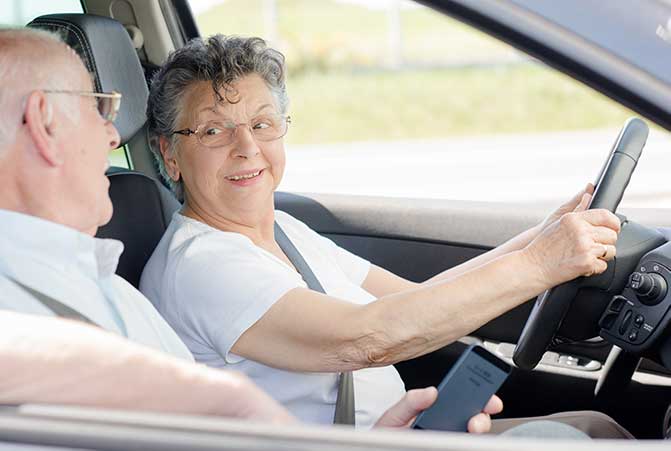
Slow down. It’s a phrase that life’s demands cause many of us to ignore. But according to 93-year-old, Elmer Jette, slowing down is a key to a long, healthy life…especially when it comes to driving.
Mr. Jette, a WWII and Vietnam veteran, is a recent “graduate” of Driving to Independence’s Bioptic Driving Assessment and Training program. As a program participant at our Tucson, AZ location, he learned to use a Bioptic Telescopic Lens (BTLS), or Bioptics, to drive. These lenses help magnify critical information such as road signs and signals to allow people with low vision time to make good driving decisions. This ultimately helps them meet visual acuity requirements to get or keep a state driver’s license.
Mr. Jette’s path to Driving to Independence wasn’t unlike other drivers with vision loss, particularly older drivers. What began as a routine visit to Costco for an eye exam put his 75+ year driving career in jeopardy. “I don’t have any health problems,” he shared, “…but they told me I couldn’t drive with my bad eye.”
Professionals from Costco directed Mr. Jette to a local optometrist who works primarily with people who need low vision devices. In Mr. Jette’s case, the optometrist prescribed Bioptics to minimize the effects of macular degeneration in his eyes. Recognizing his goal to drive, the eyecare specialist then referred Mr. Jette to the staff here at Driving to Independence.
Driving to Independence is the only adaptive driving school in Arizona performing bioptic driving assessments and training.
“We work closely with low vision specialists,” said Lea Bertoni, one of our Occupational Therapist and Certified Driver Rehabilitation Specialists. “The [eyecare specialists] tend to refer people to us for in-the-car training if their patient’s goal is to drive.”
It’s important to note that older drivers aren’t the sole users of Bioptics. Driving to Independence’s other clients have included people with albinism and Stargardt (sometimes known as Stargardt’s disease).
Participants in our bioptic driving program undergo a series of assessments to determine their suitability for the program. Lea, who facilitated Mr. Jette’s initial assessment, says this generally includes cognitive and physical testing. It also includes a passenger assessment to ensure a potential driver’s ability to identify critical traffic information such as stop signs and traffic light colors.
After passing the assessment, a driver begins training. Typically, drivers start training in residential areas and, with guidance from a Driving to Independence specialist, work toward higher traffic areas. For experienced drivers, training can take an average of 3-10 hours. For those who are completely new to driving, it takes longer.
“It was easy, and I learned a lot,” Mr. Jette said of his assessment and training experience. “I learned when to turn and how to turn.”
As part of the Strategic Air command in both WWII and Vietnam, Mr. Jette has traveled all over the world, including over 100 combat missions in Vietnam. Today, however, he is content in Tucson driving to local eateries and spending time with his wife of 73 years, Doris, and his son, who lives nearby. For Mr. Jette, a good day is getting into his 16-year-old Subaru with his Bioptics and driving with Doris to their favorite restaurant, CoCo’s, where he says, “EVERYTHING’S GOOD!”
A seasoned driver, Mr. Jette has a lot of great advice to offer: “Stay healthy. If you’re a drinker – forget it. If you want to live a long time and drive a long time, leave the bottles alone.”
Ultimately, Mr. Jette’s advice is simple for those with vision loss who may be afraid to drive: “Go get glasses. Go see the folks at Driving to Independence.”
For more information on Driving to Independence’s Bioptic Driving Assessment and Training Program, including learning about potential funding sources, check out our website or contact us directly.

Leave A Comment
You must be logged in to post a comment.